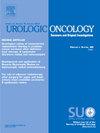nivolumab + ipilimumab与lenvatinib + pembrolizumab或nivolumab + cabozantinib联合治疗先前未经治疗的晚期肾细胞癌的实际结果比较。
IF 2.3
3区 医学
Q3 ONCOLOGY
Urologic Oncology-seminars and Original Investigations
Pub Date : 2025-08-05
DOI:10.1016/j.urolonc.2025.06.019
引用次数: 0
摘要
背景:关于nivolumab + ipilimumab (N-I)和lenvatinib + pembrolizumab (L-P)或nivolumab + cabozantinib (NC)联合治疗晚期肾细胞癌(RCC)的直接比较结果的数据有限。我们比较了N-I和L-P/NC在先前未治疗的晚期RCC中的治疗结果。方法:回顾性分析194例接受n - i(109例)和L-P/NC(85例)一线治疗的晚期RCC患者的临床资料。结果:根据治疗加权逆概率分析,L-P/NC组的无进展生存期(PFS)较N-I组更长(中位数:26.0 vs. 9.0个月,P = 0.0024),客观缓解率(ORR)较高(61.4% vs. 45.6%, P = 0.031),而两组总生存期无显著差异(中位数:未达到vs. 56.0个月,P = 0.193)。L-P/NC组不良事件发生率(97.4%比78.8%,P < 0.0001)和治疗中断率(70.5%比51.1%,P = 0.007)均高于N-I组。N-I组糖皮质激素需要率高于L-P/NC组(43.8%比27.5%,P = 0.023)。结论:与N-I相比,L-P/NC在晚期RCC患者中表现出更好的PFS和ORR。L-P/NC组有较高的不良反应和停药风险,而N-I组糖皮质激素需要率较高。了解每种免疫肿瘤联合治疗的结果特征将有助于提供最佳和个性化的治疗策略。本文章由计算机程序翻译,如有差异,请以英文原文为准。
Comparison of real-world outcomes between nivolumab plus ipilimumab and lenvatinib plus pembrolizumab or nivolumab plus cabozantinib combination therapies for previously untreated advanced renal cell carcinoma
Background
Data regarding a direct comparison of outcomes between nivolumab plus ipilimumab (N-I) and lenvatinib plus pembrolizumab (L-P) or nivolumab plus cabozantinib (N![]() C) combination therapies for advanced renal cell carcinoma (RCC) are limited. We compared treatment outcomes between N-I and L-P/N
C) combination therapies for advanced renal cell carcinoma (RCC) are limited. We compared treatment outcomes between N-I and L-P/N![]() C in previously untreated advanced RCC.
C in previously untreated advanced RCC.
Methods
The clinical data of 194 patients receiving N-I (n = 109) and L-P/N![]() C (n = 85) as first-line therapies for advanced RCC were retrospectively assessed.
C (n = 85) as first-line therapies for advanced RCC were retrospectively assessed.
Results
According to the inverse probability of treatment weighting analysis, progression-free survival (PFS) was longer (median: 26.0 vs. 9.0 months, P = 0.0024) and the objective response rate (ORR) was higher (61.4% vs. 45.6%, P = 0.031) in the L-P/N![]() C group than in the N-I group, whereas no significant difference was observed in overall survival between the groups (median: not reached vs. 56.0 months, P = 0.193). The rates of adverse events (AEs) (97.4% vs. 78.8%, P < 0.0001) and treatment interruption (70.5% vs. 51.1%, P = 0.007) were higher in the L-P/N
C group than in the N-I group, whereas no significant difference was observed in overall survival between the groups (median: not reached vs. 56.0 months, P = 0.193). The rates of adverse events (AEs) (97.4% vs. 78.8%, P < 0.0001) and treatment interruption (70.5% vs. 51.1%, P = 0.007) were higher in the L-P/N![]() C group than in the N-I group. The rate of glucocorticoid requirement was higher in the N-I group than in the L-P/N
C group than in the N-I group. The rate of glucocorticoid requirement was higher in the N-I group than in the L-P/N![]() C group (43.8% vs. 27.5%, P = 0.023).
C group (43.8% vs. 27.5%, P = 0.023).
Conclusion
L-P/N![]() C exhibited superior PFS and ORR compared with N-I in patients with advanced RCC. The L-P/N
C exhibited superior PFS and ORR compared with N-I in patients with advanced RCC. The L-P/N![]() C group harbored a higher risk of AEs and treatment withdrawal, whereas the rate of glucocorticoid requirement was higher in the N-I group. Understanding the outcome characteristics of each immuno-oncology combination therapy will help to provide optimal and individualized treatment strategies.
C group harbored a higher risk of AEs and treatment withdrawal, whereas the rate of glucocorticoid requirement was higher in the N-I group. Understanding the outcome characteristics of each immuno-oncology combination therapy will help to provide optimal and individualized treatment strategies.
求助全文
通过发布文献求助,成功后即可免费获取论文全文。
去求助
来源期刊
CiteScore
4.80
自引率
3.70%
发文量
297
审稿时长
7.6 weeks
期刊介绍:
Urologic Oncology: Seminars and Original Investigations is the official journal of the Society of Urologic Oncology. The journal publishes practical, timely, and relevant clinical and basic science research articles which address any aspect of urologic oncology. Each issue comprises original research, news and topics, survey articles providing short commentaries on other important articles in the urologic oncology literature, and reviews including an in-depth Seminar examining a specific clinical dilemma. The journal periodically publishes supplement issues devoted to areas of current interest to the urologic oncology community. Articles published are of interest to researchers and the clinicians involved in the practice of urologic oncology including urologists, oncologists, and radiologists.

 求助内容:
求助内容: 应助结果提醒方式:
应助结果提醒方式:


